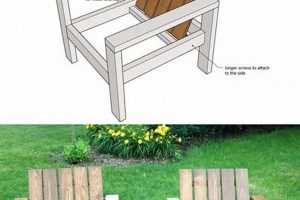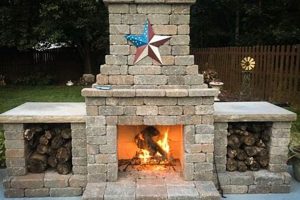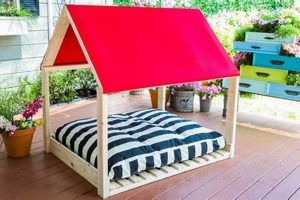Constructing supportive structures for exterior steps using personal labor and readily available materials is a project undertaken by homeowners seeking to enhance safety and accessibility. These structures provide a secure grip for ascending or descending, particularly crucial in inclement weather conditions. For example, a homeowner might choose to build a railing from treated lumber to improve stability on a garden staircase.
The implementation of such features offers multiple advantages, including increased security, prevention of falls, and improved property value. Historically, these additions were often functional necessities; however, contemporary installations frequently incorporate aesthetic elements to complement the surrounding landscape. The presence of secure support systems is particularly vital for individuals with mobility limitations, ensuring safer navigation of outdoor spaces.
The subsequent discussion will address key aspects involved in the design and construction of such safety features, including material selection, regulatory considerations, installation techniques, and essential maintenance procedures, providing a complete guide to understanding and executing this type of improvement.
Essential Guidance for Constructing Exterior Stair Supports
This section offers crucial advice for achieving a safe and durable build. Diligent application of these recommendations significantly improves the project’s success and longevity.
Tip 1: Precise Measurement and Planning: Accurately measure the staircase length, rise, and run. Develop a detailed plan or sketch, noting post placements, railing height, and any code requirements. For example, incorrect measurements can lead to insufficient rail height or non-compliant post spacing.
Tip 2: Code Compliance Verification: Research local building codes pertaining to exterior stairs. Ensure the design adheres to regulations regarding height, spacing between balusters, and post anchoring. Code violations can result in costly rework and potential fines.
Tip 3: Material Selection Based on Durability: Opt for weather-resistant materials such as pressure-treated lumber, composite materials, or powder-coated metal. Proper material choice prevents premature decay, rust, and weathering, extending the structure’s lifespan.
Tip 4: Secure Post Anchoring: Firmly anchor posts to the steps or ground using appropriate hardware and concrete footings. Inadequate anchoring compromises stability, potentially leading to collapse or failure under load.
Tip 5: Proper Spacing Between Vertical Elements: When balusters or other vertical elements are implemented, ensure spacing meets safety requirements, typically less than 4 inches. This prevents small children from passing through the railing, mitigating safety hazards.
Tip 6: Smooth Surface Finishing: Sand and seal all wooden elements to prevent splintering and weathering. Apply a durable exterior paint or stain to protect the wood and enhance its aesthetic appeal. Rough surfaces can lead to injury or accelerated material degradation.
Tip 7: Consider Lighting Integration: Integrate lighting solutions into the structure for improved visibility at night. This enhances safety and aesthetics, particularly for steps in poorly lit areas. Low-voltage LED lighting is an energy-efficient option.
Adhering to these guidelines ensures a structurally sound, safe, and visually appealing addition to the property. Careful planning and execution are paramount for a successful outcome.
The following section delves into the long-term care and preservation strategies for this essential element.
1. Safety
The integration of safety measures into the design and construction of exterior stair supports is not merely a recommendation but a fundamental requirement. Adequate support structures mitigate the risk of falls and injuries, particularly in adverse weather conditions or for individuals with mobility limitations. The following details the multifaceted nature of this critical aspect.
- Fall Prevention
The primary function of a railing is to prevent falls. Proper railing height, graspability, and secure anchoring are essential for providing stable support. Consider the scenario of an elderly person navigating icy steps; a well-constructed handrail can be the difference between a safe passage and a serious injury. Failures in this aspect have severe consequences.
- Adherence to Building Codes
Building codes stipulate specific requirements for railings to ensure safety. These regulations often cover height, spacing between balusters, and structural load capacity. Non-compliance can result in hazardous conditions and legal liabilities. For instance, insufficient baluster spacing can pose a risk to small children.
- Material Integrity and Durability
The materials used must be capable of withstanding environmental stressors and sustained use. Deterioration due to rot, rust, or impact damage can compromise structural integrity. Regularly inspect wooden handrails for signs of decay and metal railings for corrosion. A seemingly minor imperfection can escalate into a significant safety hazard.
- Visibility and Illumination
Adequate lighting around stairways is crucial for safe navigation, particularly at night or in low-light conditions. Integrate lighting solutions into the railing design to improve visibility. This is especially important for stairs with uneven treads or unexpected changes in direction. Poor visibility significantly increases the risk of missteps and falls.
In summary, safety is inextricably linked to the design and construction of DIY exterior stair supports. From preventing falls through proper dimensions and materials to complying with stringent building codes and ensuring adequate visibility, each aspect plays a vital role in minimizing risk and promoting user well-being. Neglecting any of these facets can lead to serious consequences, underscoring the importance of meticulous planning and execution.
2. Durability
The lifespan of exterior stair supports constructed through personal effort directly correlates with the materials employed and the rigor of construction techniques. Reduced longevity leads to increased maintenance, replacement costs, and potential safety hazards.
- Material Selection and Weather Resistance
The choice of materials is paramount in determining long-term performance. Options such as pressure-treated lumber, composite materials, and powder-coated metal offer varying degrees of resistance to moisture, UV radiation, and temperature fluctuations. For example, untreated wood exposed to cyclical wetting and drying will experience accelerated decay compared to pressure-treated alternatives. The selection process must prioritize materials that can withstand the specific climatic conditions of the installation environment.
- Joint Integrity and Fastener Corrosion
The methods used to join components significantly impact structural integrity. Properly executed joints, secured with corrosion-resistant fasteners, prevent premature weakening and separation. The use of galvanized or stainless-steel fasteners is essential in preventing rust and maintaining joint strength. Improperly joined elements, or the use of inadequate fasteners, can lead to instability and eventual failure under load.
- Protective Coatings and Sealants
The application of protective coatings, such as paints, stains, and sealants, provides an additional layer of defense against environmental degradation. These coatings reduce moisture penetration, mitigate UV damage, and inhibit biological growth. Regular reapplication of these treatments is necessary to maintain their protective properties. Neglecting these protective measures accelerates material breakdown and shortens the structure’s service life.
- Structural Design and Load Capacity
The design of the support system must account for anticipated loads, including pedestrian traffic, snow accumulation, and wind forces. Under-engineered designs or insufficient support members can result in structural fatigue and eventual collapse. Adherence to established engineering principles and building codes is crucial in ensuring the system’s load-bearing capacity and overall durability. A robust design, coupled with appropriate material selection, is essential for withstanding sustained use and environmental stresses.
Ultimately, the durability of exterior stair supports created independently relies on a confluence of factors, from material choices to construction practices and ongoing maintenance. A commitment to sound engineering principles, combined with the selection of robust materials and diligent upkeep, ensures that the structure provides safe and reliable support for an extended period.
3. Code Compliance
Adherence to local building codes is a non-negotiable aspect of constructing exterior stair supports. These codes, established by governing bodies, dictate minimum safety standards for structural elements. Failure to comply with these regulations can result in legal ramifications, including fines and mandated reconstruction. More significantly, non-compliant structures pose inherent safety risks to users, potentially leading to injuries or fatalities. Building codes typically specify requirements for railing height, the spacing between balusters or other infill components, the load-bearing capacity of the railing system, and the method of anchoring the posts to the stairs or ground. For instance, many codes require a minimum railing height of 36 inches and a maximum baluster spacing of 4 inches to prevent small children from falling through.
The practical significance of understanding and adhering to these codes is multi-fold. Firstly, compliance ensures the safety and well-being of individuals using the stairs. Code-compliant railings provide adequate support and prevent falls, especially for the elderly or those with mobility issues. Secondly, adherence to codes protects homeowners from potential legal liability in the event of an accident on their property. A homeowner who constructs a railing that does not meet code requirements may be held liable for injuries sustained by visitors. Thirdly, code compliance can facilitate the resale of the property. Prospective buyers often conduct inspections to ensure that all structures on the property meet current building codes. Non-compliant railings can be a significant deterrent to potential buyers and may necessitate costly repairs prior to sale. A real-world example would be a homeowner who, in an attempt to save money, uses undersized posts that fail to meet the load-bearing requirements of the local code. This railing could collapse under stress, leading to injury and potential legal action.
In conclusion, code compliance is an indispensable element of any exterior stair support project. While self-construction offers potential cost savings, neglecting code requirements introduces unacceptable risks. Homeowners should consult with local building officials or qualified contractors to ensure their designs and construction methods meet all applicable regulations. The effort invested in ensuring code compliance is a worthwhile investment in safety, legal protection, and long-term property value. This investment safeguards both the occupants of the dwelling and any visitors navigating the outdoor stair system.
4. Material Choice
The selection of materials directly influences the safety, longevity, and aesthetic appeal of exterior stair supports. Careful consideration of material properties, environmental factors, and budget constraints is crucial for successful self-construction.
- Wood Species and Treatment
Different wood species exhibit varying degrees of resistance to decay, insect infestation, and weathering. Pressure-treated lumber is a common choice due to its enhanced resistance to rot and insect damage. However, untreated cedar or redwood offer natural resistance and can be suitable for certain climates. In coastal environments, the use of marine-grade lumber is advisable. The type of wood chosen significantly impacts the maintenance requirements and the overall lifespan of the structure.
- Metal Alloys and Coatings
Metal railings offer strength and durability but require careful selection of alloys and coatings to prevent corrosion. Aluminum is lightweight and corrosion-resistant but may lack the structural strength of steel. Steel, when properly galvanized or powder-coated, provides robust support and resists rust. Stainless steel offers superior corrosion resistance but is typically more expensive. The choice of metal influences both the structural integrity and the long-term aesthetic appeal of the railing.
- Composite Materials
Composite materials, typically consisting of wood fibers and plastic polymers, offer a low-maintenance alternative to natural wood. These materials resist rot, insect damage, and warping, requiring minimal upkeep. However, composite materials may have a higher initial cost and may not offer the same aesthetic appeal as natural wood. The selection of composite materials is often driven by a desire for reduced maintenance and increased longevity.
- Fasteners and Hardware
The selection of appropriate fasteners and hardware is essential for ensuring structural integrity and preventing premature failure. Galvanized or stainless-steel screws and bolts should be used to resist corrosion. Improper fastener selection can lead to weakened joints and structural instability. The long-term performance of a railing system depends not only on the primary building materials but also on the quality and suitability of the connecting hardware.
The decision regarding material choice is not solely based on cost or aesthetics. The interplay between environmental conditions, desired lifespan, and required maintenance must be carefully considered. For example, a homeowner in a humid climate might prioritize pressure-treated lumber or composite materials to minimize rot, while a homeowner in a dry climate might opt for naturally resistant wood species. A well-informed selection process ensures that the railing system provides safe, reliable, and visually appealing support for many years.
5. Installation
The process of erecting independently constructed exterior stair supports represents a critical stage in realizing a safe and functional addition to a property. Correct installation methods are paramount for ensuring structural integrity and long-term stability. Improperly executed installations can compromise safety and necessitate costly repairs.
- Post Setting and Anchoring
The secure anchoring of posts is fundamental to the overall stability of the railing system. Posts must be firmly set in concrete footings or attached to existing structures using appropriate hardware. The depth and diameter of the footings should adhere to local building codes and account for soil conditions. Inadequate anchoring can lead to post instability and potential collapse under load. An example includes a post set in shallow footing being uprooted during freeze-thaw cycles, weakening the handrail.
- Railing Attachment Techniques
The method of attaching railings to posts significantly impacts the structural integrity of the system. Rails must be securely fastened using appropriate hardware, such as screws or bolts. The spacing and number of fasteners should be sufficient to distribute the load evenly. Improper attachment can result in loose railings and potential safety hazards. For instance, using only nails to attach railings can lead to loosening over time due to vibration and weather exposure.
- Leveling and Alignment
Precise leveling and alignment are essential for creating a visually appealing and functionally sound railing system. Rails should be installed parallel to the stair treads and consistently spaced. Deviations from level or alignment can create tripping hazards and detract from the aesthetic appeal of the installation. Using a level and string line can ensure accurate alignment throughout the project.
- Code Compliance Verification
Throughout the installation process, it is crucial to verify adherence to local building codes. This includes ensuring that the railing height, baluster spacing, and post spacing meet the minimum requirements. Failure to comply with these codes can result in rejection by building inspectors and necessitate costly rework. A pre-installation inspection by a building official can prevent costly errors and ensure compliance with all applicable regulations.
These facets underscore the importance of meticulous planning and execution during the erection phase. Each step, from post anchoring to railing attachment and code verification, contributes to the overall safety, durability, and regulatory compliance of self-constructed outdoor stair supports. Proper installation is not merely an aesthetic consideration; it is a fundamental requirement for ensuring the long-term functionality and safety of the structure.
6. Aesthetics
The visual appearance of independently constructed exterior stair supports significantly impacts property value and overall curb appeal. While functional safety remains the paramount concern, the integration of aesthetic considerations enhances the structure’s contribution to the surrounding environment. The materials chosen, the design implemented, and the finishing techniques applied collectively influence the visual harmony between the stair supports and the architecture of the dwelling. For instance, a railing constructed from rough-hewn timbers might complement a rustic cabin, whereas a sleek metal railing could better suit a modern home. Failing to consider these aesthetic relationships can result in a discordant visual element that detracts from the property’s overall value. The design choices directly cause either an increase or a decrease in the perceived beauty of the property.
Aesthetic elements within the context of exterior stair supports encompass several key factors. The style of the railing (e.g., traditional, contemporary, minimalist) must align with the architectural style of the house. The color and texture of the materials should harmonize with the existing color palette of the building and landscape. Furthermore, the design can incorporate decorative elements, such as ornamental metalwork or carved wood details, to enhance its visual interest. The scale and proportions of the railing should be appropriate for the size and style of the staircase. In a practical sense, a railing system with a simple, clean design can often enhance the sense of spaciousness, while an overly ornate design might visually overwhelm a small staircase. Proper aesthetics, therefore, become an integral part of overall function and value.
In summation, attention to aesthetic detail in the construction of DIY exterior stair supports elevates the project beyond mere functionality. By carefully selecting materials, designs, and finishes that complement the surrounding architecture and landscape, homeowners can enhance their property’s curb appeal and overall value. Challenges in achieving desired aesthetics may include balancing personal preferences with broader architectural styles and budget constraints. However, the effort invested in aesthetic considerations yields tangible benefits, transforming a utilitarian structure into a visually pleasing element of the property.
7. Maintenance
Preservation activities constitute a critical component of ensuring the longevity, safety, and aesthetic appeal of exterior stair supports constructed through self-directed efforts. Inadequate maintenance protocols result in accelerated material degradation, increased safety risks, and diminished property value.
- Regular Inspection and Cleaning
Periodic visual inspections are necessary to identify signs of damage, decay, or corrosion. Cleaning removes accumulated dirt, debris, and biological growth that can contribute to material breakdown. For example, accumulated leaf litter on wooden railings can trap moisture, promoting rot. A routine inspection and cleaning schedule helps prevent minor issues from escalating into significant problems.
- Protective Coating Reapplication
Exterior coatings, such as paints, stains, and sealants, provide a protective barrier against environmental elements. Over time, these coatings degrade due to UV exposure, moisture, and abrasion. Reapplication of protective coatings is necessary to maintain their effectiveness. Neglecting to reapply coatings can lead to accelerated material degradation and increased maintenance costs. A weathered, peeling paint finish not only detracts from the visual appeal of the railing but also exposes the underlying material to harmful environmental factors.
- Fastener and Joint Assessment
Fasteners and joints are critical structural elements that require periodic assessment. Loose or corroded fasteners can compromise the stability of the railing system. Damaged or weakened joints can create safety hazards. Replacement of corroded fasteners and reinforcement of weakened joints are essential maintenance tasks. Example: a screw holding a railing is starting to come loose and is corroded so this should be inspected and replaced immediately.
- Structural Repair and Reinforcement
Significant damage, such as wood rot or metal corrosion, may necessitate structural repair or reinforcement. Deteriorated components should be replaced or reinforced to maintain the integrity of the railing system. Neglecting structural repairs can lead to catastrophic failure and potential injury. For instance, replacing a rotting post is essential for maintaining the stability of the entire railing structure.
These maintenance activities, when diligently performed, preserve the functional and aesthetic value of exterior stair supports assembled through personal initiative. A proactive maintenance approach ensures a safe and visually pleasing structure for an extended duration, mitigating the risks associated with material degradation and structural instability.
Frequently Asked Questions
This section addresses common inquiries regarding the planning, construction, and maintenance of independently built exterior stair safety features. The information provided aims to clarify key considerations and dispel potential misconceptions.
Question 1: What constitutes an adequate post depth for securing a wooden railing post in soil?
The required depth varies depending on local frost lines and soil conditions. Consult local building codes; however, a minimum depth of 24 inches is generally recommended. The diameter of the concrete footing should also be considered to provide adequate lateral support.
Question 2: Is pressure-treated lumber inherently safe for contact with soil and humans?
Modern pressure-treated lumber uses chemicals that are generally considered safe for residential use. However, direct and prolonged skin contact should be avoided. Always follow the manufacturer’s guidelines for safe handling and disposal.
Question 3: How often should exterior railings be inspected for potential safety hazards?
A minimum of twice per year is advised, typically in the spring and fall. More frequent inspections are warranted in areas prone to extreme weather conditions or high usage.
Question 4: Are there alternatives to concrete for securing railing posts?
Yes, alternatives include mechanical anchors designed for direct attachment to existing concrete surfaces, and specialized ground screws. However, the suitability of these alternatives depends on the specific site conditions and the load-bearing requirements of the railing system. Always verify that the chosen method meets local building codes.
Question 5: What are the primary indicators of rot in wooden railing components?
Key indicators include discoloration, softening of the wood, visible fungal growth, and a musty odor. A screwdriver can be used to probe suspect areas; if the wood is easily penetrated, rot is likely present.
Question 6: What is the recommended method for attaching metal railings to wooden posts?
Use galvanized or stainless steel fasteners to prevent corrosion. Pre-drilling pilot holes is essential to prevent splitting the wood. Ensure that the fasteners are appropriately sized for the thickness of both the metal railing and the wooden post.
These answers represent general guidelines. Always consult with qualified professionals and local building codes for specific requirements and recommendations pertaining to the project.
The succeeding section provides a detailed summary of the preceding information.
DIY Handrails for Outdoor Stairs
This exploration of constructing diy handrails for outdoor stairs underscores several crucial facets. Safety, code compliance, material selection, proper installation, aesthetic considerations, and consistent maintenance emerge as indispensable elements for a successful project. Neglecting any of these aspects compromises the structural integrity, longevity, and regulatory adherence of the resulting construction.
The information presented serves as a foundational guide for individuals undertaking this type of endeavor. Prudent application of these principles is paramount, ensuring that these additions not only enhance property value but, more importantly, provide a safe and secure passage for all users, today and in the years to come. Prioritizing meticulous planning and diligent execution remains crucial.







